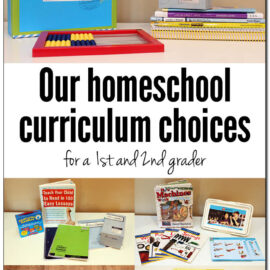This post may contain affiliate ads at no cost to you. See my disclosures for more information.
You have decided on home education and are starting to move forward with this big responsibility. Now it’s time to determine your homeschool style.
(Still undecided if homeschooling is right for you? Read this article first.)
Not sure what a “homeschool style” is?
While homeschoolers in most states are required to teach the basic subjects, how those subjects get taught can vary widely from one homeschool family to another. Some families have a style that closely mirrors what happens in a traditional classroom, while other families prefer a very different approach.
In this article I discuss eight common styles of homeschooling and give you some tips for determining what your preferred style is.

Determining your Homeschool Style
To determine your homeschool style you will want to consider your reasons for homeschooling and how you want to spend your days with your children.
Do you see yourself having a hierarchical relationship with your child where you are the teacher who imparts knowledge to your children? Or do you see yourself as a co-learner traveling with your child on their educational journey?
Do you and your kids thrive on structure and routine? Or do you prefer to be free flowing and take things moment by moment?
Do you prefer to learn from textbooks and worksheets or from experiences and life outside the home?
There are no right or wrong answers to these questions. There is only what is right for you and your family. But thinking these issues through will help you identify the homeschool style that best fits you.
And once you’ve identified your homeschool style, it will be easier to decide on what curriculum you want to use. . . or to decide not to use any curriculum at all!
Is a Traditional Homeschool Style the Right Educational Philosophy for Your Family?
Families just starting out on their homeschooling journey may lean toward a more traditional homeschool educational philosophy, as this is the style most people are familiar with from their time in a traditional classroom.
The default idea of homeschooling to many looks like a family gathered together, sitting at desks or the kitchen table, with children working through textbooks while a parent looks on. Families may start their school day at 9 am and end their day at 3 pm. In other words, a traditional style tries to replicate a school environment at home.
Veteran homeschooling families recognize that while this method is common, it is not the only way. And it’s not even the best way. In fact, it’s a good way to foster burnout.
If you go through a deschooling process when you transition into homeschooling – something I highly recommend – you will likely recognize very quickly that your children can learn a lot without you having to replicate what happens at school.
The Classical Education Approach to Learning
Parents who prefer an analytical approach to learning may wish to consider classical homeschooling. This philosophy approaches learning in three stages called the Trivium. The first stage, between ages 6 and 10, is the Grammar Stage. During this stage, children focus on absorbing information and memorizing the rules of phonics, spelling, grammar, foreign language, history, science, math, etc.
The second stage, known as the Dialectic Stage, occurs between ages 10 and 12. During this stage, children are presented with questions and logic. They’ll take the facts that they memorized during the elementary grades and expand upon them. Students use life experiences and encounters to dig in with curiosity to figure things out for themselves.
The final stage, known as the Rhetoric Stage, is for students between 13 and 18 years of age. During this stage, students are encouraged to express their feelings and thoughts. There is an emphasis on communication and helping students express their ideas and understandings clearly and persuasively.
Each stage of the trivium builds upon what was explored in the previous stage. This hopefully results in a child who can take in and understand information and form their own opinions. They then are taught to convey those thoughts and feelings in a variety of ways. These are valuable skills to have in an ever-changing, fast-paced world where seemingly everyone has a voice. Families looking to raise children with discernment may appreciate this homeschool methodology. Learn more about classical education to see if it might be a fit for your family.
Learning through Unit Studies
The unit study approach to homeschooling is unique in that it can be done in a variety of ways. With a unit study – sometimes called a thematic unit or an integrated study – students study a particular topic in depth through a variety of lenses. Multiple subjects are woven into the unit study and learning happens in context rather than remote from any real-world application.
For example, a child with an interest in Ancient Egypt may do a unit study to learn about the historical significance of the time period. However, science, math, language arts, and art can all be woven into the topic.
Learning through unit studies is a great option for families who enjoy taking deep dives on a particular topic and who are open to researching more about particular areas of interest. Unit studies typically incorporate a lot of hands-on learning, which is great for keeping children engaged. Cooking, science experiments, and even acting out scenes from history books are all examples of hands-on learning. Unit studies foster true and authentic learning opportunities.
Some parents prefer to create their own unit studies specifically tailored to their child’s interests. If there is a particular subject area your child is interested in, you can likely do a search online for unit studies related to that subject and come up with plenty of ideas. Or you can buy pre-made unit study curriculum that fits the topics your child wishes to learn about.
Characteristics of a Waldorf-inspired Home and Family
Rudolph Steiner believed in the development of the whole child, including mind, body, and spirit. A Waldorf-based education caters to a child’s sense of wonderment, imagination, and creativity. The Waldorf philosophy de-emphasizes academics in the early years in favor of focusing on age-appropriate learning. Waldorf places a lot of emphasis on nature, so curriculum can be inexpensive if you spend much of your day enjoying the outdoors.
In a Waldorf-inspired homeschool, children create beautiful artwork and writings about the lessons and reading they do. The ”main lessons books” become both a portfolio and a textbook for the child.
If you lean toward a more gentle approach to learning, Waldorf may work for your family. Those who value meaningful handwork like knitting, and encourage storytelling, movement, and imagination, will appreciate this philosophy. The YouTube channel, Sunday’s with Sarah, is a great resource for parents exploring a Waldorf education.
Setting up a Montessori Prepared Environment for your Homeschool
If you envision child-directed, hands-on experiences in your homeschool, a Montessori-inspired homeschool may be one to consider. Educator Marie Montessori coached instructors to prepare an inviting environment for children. She encouraged teachers to allow the children to take center stage and direct the learning in a prepared environment.
Much of the early learning involves tactile experiences in the form of cutting and pasting, pouring, and constructing. Montessori resources, tools, and supplies can be expensive, but many parents create their own materials inexpensively. The key is to place activities on a child’s level and teach them how to care for the supplies, use them, and put them away properly.
Some families choose the Montessori method of homeschooling for the preschool and early elementary years. It is possible, though, to extend the philosophy throughout your child’s education. Learn more about Maria Montessori’s vision for learning to determine whether or not it’s the right choice for your child.
Parents who wish to train in this method might consider enrolling in KHT Montessori’s 12 month online certificate program.
A focus on “Living Books” with a Charlotte Mason Education
Charlotte Mason emphasized the importance of a parent’s role in their child’s development. As a child’s first educator, the parents should be good models of behavior and attitude. Mason also encouraged the importance of developing good habits and character, as well as learning through nature. She promoted the use of “living books” – books written by authors who are passionate about a subject – as compared to learning through typically dry textbooks.
Families who love to read together and who prefer a gentle parenting method may gravitate toward this relaxed homeschool methodology. If you are looking to explore Charlotte Mason and her ideas further, you may find her writings helpful in navigating the waters of this unique homeschool style.
Unschooling as a Homeschool Style for Free-Range Families
Unschooling families take the ‘less is more’ approach to home education. They allow children to learn in a natural and organic way. Usually, without a curriculum, they simply live life and let education come on its own. However, there are as many ‘degrees’ of unschooling as there are families who opt for this unique philosophy in their home.
If you’ve done research on unschooling you may have encountered varying opinions on the topic. Passionate unschoolers have strong beliefs about what unschooling is and what it isn’t. For example, some will say that if you use any curriculum at all, you are not unschooling. Others take a more flexible attitude and say that they key to unschooling is to follow your child’s interests and allow them to learn as naturally as possible.
The key is to figure out if this style fits your family. If your family actively seeks out educational activities and you’re committed to cultivating an environment of curiosity alongside your children free from the constraints of typical curricular programs, unschooling may be a good fit.
Eclectic homeschooling: The best of all worlds?
Some families have a hard time choosing just one of these styles, and thus bring in elements of multiple styles and philosophies at different times. For these eclectic homeschoolers, there are no limits. Families can use any and all philosophies to create an individualized learning experience for their children.
This approach may be ideal for the new homeschooling family who might be unsure of which path to take. Since this is your homeschool, you have the authority to facilitate it in the way that works best for both you and your child. Taking an eclectic approach is a fun way to dip your toes into the experience. It allows you to not get caught up in the doubt and worry of whether or not you’re ‘doing it right.’
You Will Eventually Understand Your Homeschool Style
Understanding your homeschool style often takes experimentation coupled with reflection. With some research and a bit of trial and error, you’ll find the methodology that works for your family. The key is to take what works and dismiss what doesn’t.
When understanding your educational philosophy, the goal is to make the philosophy or perspective work for you and your family, instead of trying to make your homeschool fit into the box of the philosophy. A rigid, regimented attitude toward an educational philosophy can be a detriment to your homeschool. Build in some wiggle room around your educational style, and approach your children with curiosity and love, and you truly can’t go wrong in your homeschool.
Whichever path you choose, it is important you know how to homeschool legally in your state. Homeschooling is legal in every state in the U.S., but each state is responsible for its own individual laws around home education. Be sure you’re up-to-date with the legalities of homeschooling where you live and make sure to adapt the educational philosophy you choose so that you meet the legal requirements for your area.





Great read!!! Thanks for sharing such a great blog, blog like these is really helpful.